“Why does Facebook constantly change its algorithm? I can never keep up.”
“We’re the ones giving them money. Why are they always making it harder on us to get our content to our audience?”
You're not alone if you’ve ever asked either of those questions.
For years, marketers and advertisers have been noticing changes to Facebook’s algorithm. Each time, these changes only seemed to hurt their organic reach and ad performance with Facebook marketing.
Though the Facebook algorithm isn’t the only thing affecting the reach of your content, it is one of the most important. That’s why all marketers must stay up to date on the changes and updates as Facebook rolls them out.
In this article, we’ll discuss the major milestones the Facebook algorithm has been through over the years and what they mean for your business.
We’ve also included 19 effective strategies to help you defeat the algorithm, increase your reach, and boost your loyal customer base down the line. 🤑
- What is the Facebook algorithm?
- Facebook algorithm changes and milestones over time
- 19 strategies to beat the Facebook algorithm
- 1. Start conversations
- 2. Speak to your audience
- 3. Get local
- 4. Leverage Facebook Insights
- 5. Post at the right time
- 6. Avoid “down ranked” content
- 7. Be video-focused
- 8. Be consistent, consistently
- 9. Join relevant Facebook Groups
- 10. Ask for follows (the right way)
- 11. Have your audience prioritize you
- 12. Ask open-ended questions
- 12. Get brand advocates involved
- 14. Put the platform first
- 15. Make each post unique, even if it’s repurposed
- 16. Make it Facebook official
- 17. Utilize hashtags
- 18. Reply to your audience
- 19. Don’t forget the power of paid ads
- Go tackle that Facebook algorithm with confidence
Get brand new Facebook ad strategies straight to your inbox every week. 23,739 people already are!
What is the Facebook algorithm?
Essentially, the Facebook algorithm is machine learning that determines what you see on your news feed when you log into the platform.
Understanding how it works is where it can get tricky. Luckily, in 2020, Facebook made an effort to help everyone across the web understand it.
How the Facebook algorithm works
The algorithm can be boiled down to 4 main factors:
- Inventory
- Ranking Signals
- Prediction
- Score
Inventory is all of the available content that lives on Facebook, which could potentially live on a user’s feed.
Ranking Signals are indicators that help Facebook prioritize what should be shown to each user. While a lot of signals go into the ranking, the elements Facebook values the most are
- who: the friends, family members, or organizations you interact with the most
- type of content: the types of posts Facebook users prefer, whether that’s videos, photos, articles, links, etc.
- interactions with post: the number of likes, reactions, comments, and shares (with priority given to engagements from the people you typically interact with)
Prediction utilizes past behavior and what Facebook knows about you and your habits to reasonably predict what content you are more likely to engage with and from whom.
Score is Facebook’s quality ranking for every piece of content out there. The higher the relevance, the higher the score. And the higher the score, the more likely it is you’ll show up on the Facebook Feed.
One important thing to keep in mind is Facebook’s priorities regarding user experience. Historically, what the algorithm prioritizes in a Facebook user’s feed depends on what’s going to provide the most relevant, connecting social experience for each user.
And that’s where the algorithm’s milestones come into play. From 2016 forward, Facebook has been redefining what they consider the best user experience to be, resulting in the algorithmic changes we’ve seen so far.
So, to help you get a better understanding, let’s dive into those milestones.
Facebook algorithm changes and milestones over time
The list of important events in Facebook algorithm history will continue to build year over year. Each year presents new feedback and new problems to solve.
For now, we’ve put together a list of the most important things of note across the history of Facebook algorithm updates and important milestones. And as the algorithm’s history grows, this list will, too.
Likes first
In 2009, Facebook scrapped the chronological order of the news feed. Instead, Facebook started pushing the most popular posts that had the most likes to the top of the news feed, rather than the most recent posts.
Story bumping
A fairly simple (but effective) update, Facebook introduced “story bumping” in 2013. This algorithmic change bumped relevant content that was previously missed by a user to the top of the page the next time they logged in.
According to Forbes, this change accounted for a 5% increase in interaction on friends’ Facebook stories, and an 8% increase in interaction on content from relevant pages.
“See First”
In 2015, we saw the introduction of Facebook’s “See First” feature. This allowed users to customize the content they wanted to see first—whether it be from specific people, pages, or brands.
This feature also gave users the power to “pause” or “unfollow” certain people, pages, or brands, as well as opt to “see less” of their content.
Friends and family first
In 2016, Facebook started shaping the connections-first algorithm.
At this time, they made a push to begin prioritizing posts from friends and family over posts from brands and publishers.
A post’s value was then based on the time spent with it, including an emphasis on live video.
This is where Facebook started making the push for engagement value and close friends above all else, moving to the core of why Facebook was originally created: to connect users all over the world.
More weight for emoji reactions
2016 is also when they introduced new reactions outside of the standard “likes,” such as the heart and angry face emoji.
On its own, this may seem like a surface-level change, but it did actually have significant importance. The algorithm started giving more weight to emoji reactions than to a regular like, so posts with a higher count of emoji reactions were prioritized.
Introducing the era of video
The “era of video” began in 2017. This is when a push was made to focus on quality Facebook videos and specifically video completion rates.
Quality videos that people were actually watching past the halfway point and Facebook live videos that had high engagement started becoming a higher priority in news feeds.
Engagement is paramount
In 2018, Facebook continued the push for quality content and “bringing us closer together.”
What Mark Zuckerberg meant by that was that the algorithm would begin evaluating who you interact with more frequently and prioritize their posts in your feed.
This was a big concern for a lot of new brands. Under this version of the algorithm, it would be harder for them to build engagement and an audience if users’ most frequent interactions determined the content they saw.
To adapt, brands began to post and publish a kind of content that aimed for high-quality engagement, which was more important than ever before.
Tailoring feeds with surveys
Starting in 2019, Facebook began to make feeds even more personal by introducing surveys. The goal here was to find out even more information about brands you like and dislike and what type of content you prefer outside of just friends and family.
This helped the algorithm better tailor its feed to users’ preferences and put them in control of what they saw when they logged in.
Controversial and “fringe” content in feeds
2019 also became a year of controversy due to how the algorithm worked.
A study in May of 2019 found that controversial and “fringe” content was also being prioritized.
Posts that sparked controversy got people to react, which turned controversial posts into “high-engagement” posts and pushed them to the top of users’ news feeds.
During this time, all news sites and publishers saw significant boosts in engagement.
Pushing video further
That wasn’t the end for algorithmic events in 2019. Facebook also continued its video push.
This time, Facebook announced they will continue to push not just video and video completion, but quality, original videos. They also continued prioritizing video viewing duration and introduced the priority of video loyalty (returning viewers).
Comment control
In 2021, Facebook started giving users even more control over their news feeds. One example was the ability to choose who gets to comment on your posts.
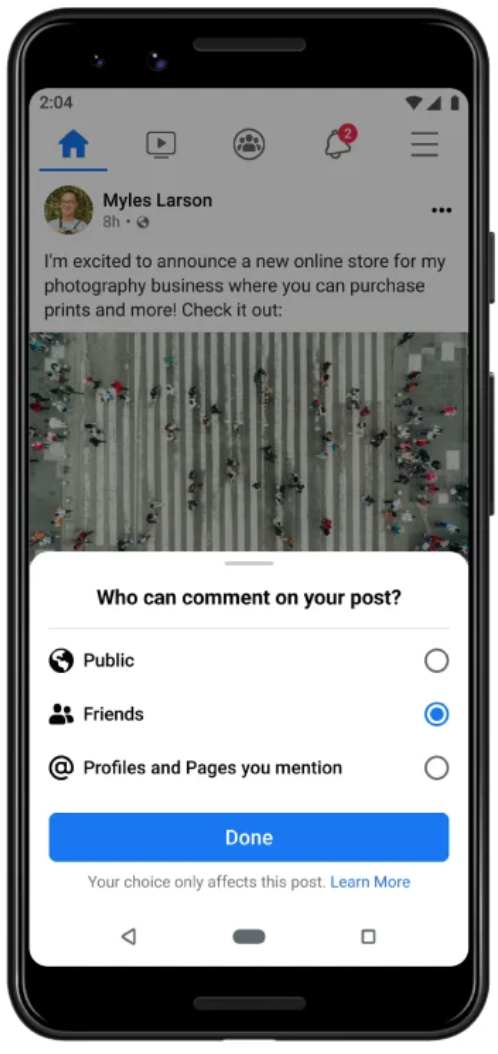
This was an attempt to allow users to avoid unwanted or distasteful conversations from those they don’t know. It’s also a part of Facebook’s effort to improve the “community aspect” of the platform.
As Facebook puts it, allowing you to control your commenting audience enables you to “engage in more meaningful conversations with your community.”
“Favorites”
Part two of the 2021 push for more user control involved the introduction of the Favorites feature. An enhanced version of “See First,” Favorites allows users to select up to 30 pages or people whom they want to see content from in their news feeds.
People and pages in a user’s Favorites will be prioritized highest in their news feed. Users can also filter their feed to only see posts from their Favorites.
In a digital age where privacy is becoming paramount, you can imagine how this might be a distressing feature for some businesses. If everyone’s only looking at their Favorites, how will posts and ads from business pages be seen?
The not-so-simple solution is for businesses to make engaging content and earn their spot on the Favorites list of a user base. But—let’s be real—even with excellent content, this can be difficult to do.
Before you panic, that’s not the only way people will see content from businesses. Check out the image below to see what we mean about “filtering.”
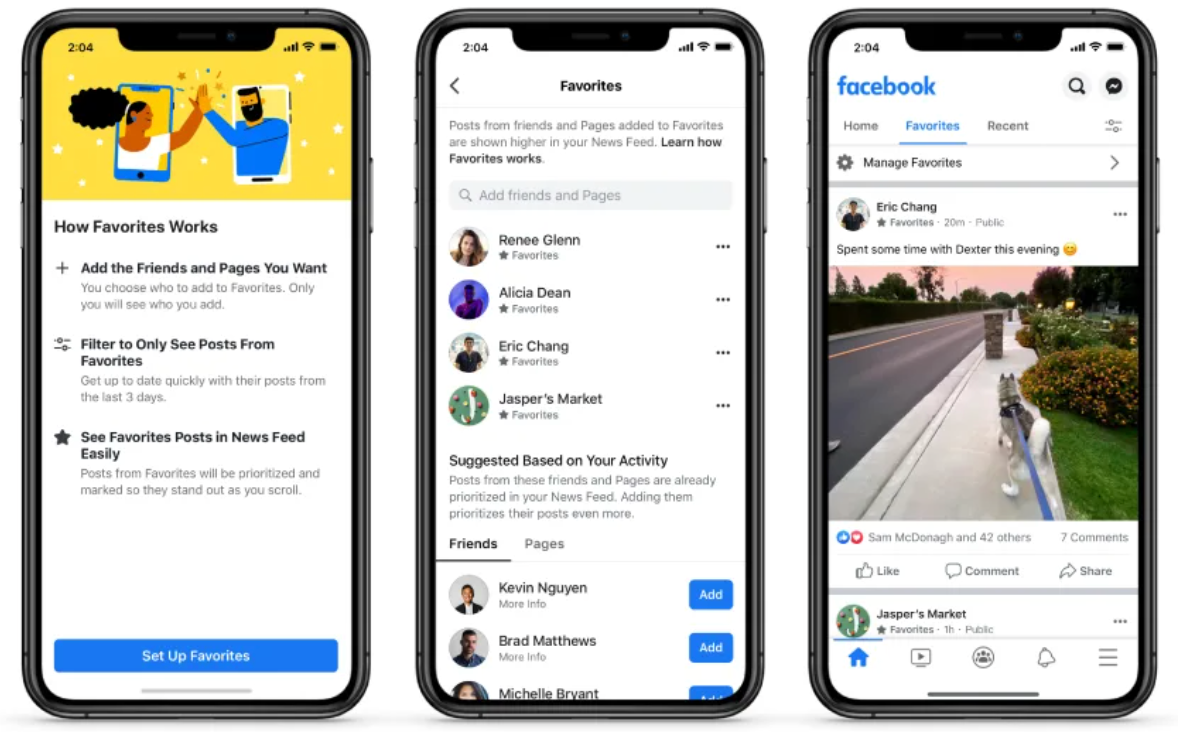
In the rightmost image in the screenshot above, you’ll see the new “filter bar” also launched in 2021. With this, users can tap the “Favorites” tab to flip through the last 3 days' worth of posts only from their Favorites.
They can also use the “Recent” filter to see content from relevant people and pages in chronological order. Ads and relevant content from businesses can be seen here.
And when someone navigates to the home page, content there will prioritize favorites, but not be exclusive to them. So ads and content from businesses can still be seen there, too.
Scrapping the “news” of “news feed”
This one’s not so much a change in the algorithm as it is a cosmetic change in how the algorithm and the Facebook feed are perceived.
In 2022, Facebook decided to change the naming of its “news feed” to just “feed,” possibly as a way to dissociate the platform from being considered a “news source.”
This is also branding that’s consistent with Facebook’s continued desire to connect people in meaningful ways, and to discourage “consuming media in isolation.”
19 strategies to beat the Facebook algorithm
Now that you’ve got a better idea of where the algorithm has been and where it is now, you’ve probably gained a better understanding of how it’s hindering your brand’s exposure.
With Facebook striving to be a better people-connecting platform and endeavoring to give more power to users to decide what they see in their feed, it’s getting increasingly difficult for brands (especially new ones) to break the veil.
But that’s where we come in.
By looking at what’s happened to the algorithm in the past and understanding what values it prioritizes in crafting relevant feeds for users today, we can figure out how to roll with the punches.
So hang tight—we’re going to fly through 19 ways you can beat the algorithm and get your brand in front of interested eyes.
1. Start conversations
Here, the goal is to start conversations that get people talking on your posts and ads. We know that signals are key, so getting more signals to your post will help improve your ranking over time.
Social engagement is key to helping your organic posts rank higher and getting your ads to perform better.
The easiest way to do this is to be genuine. A lot of people think building controversy is the way to go. Although that can sometimes be effective, that shouldn’t be the exclusive marketing strategy you resort to.
Other great ways are to be funny and entertaining. You can also talk about what’s popular and “in,” or share interesting and inspiring topics. Also, why not ask questions? This doesn't mean yes or no questions. Open-ended questions get the ball rolling. Mix that in with some tasteful (and light) controversy from time to time, and you’ll have a winning formula.
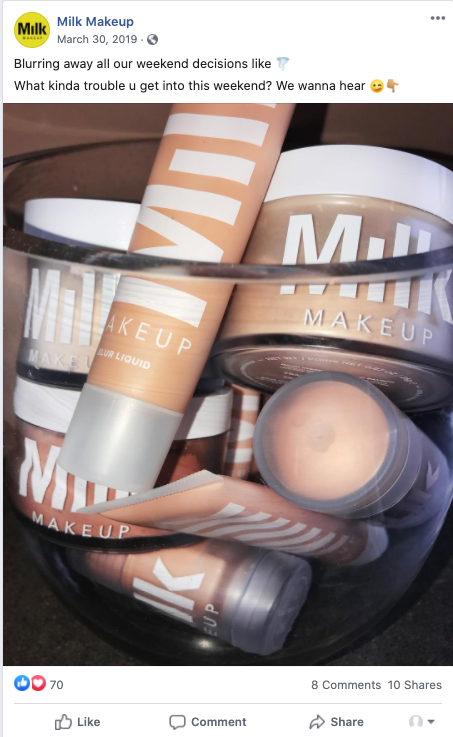
Milk Makeup does a great job starting a conversation by asking their audience what their weekend plans were—and by asking what kind of trouble they’re planning to get into.
2. Speak to your audience
Facebook is one of the best social network platforms out there due to its targeting capabilities—not just for paid ads, but organic posts as well. Facebook has an option to set preferences for who can see each post.
The goal here is to focus on engagement in an effort to try to increase responsiveness on your ads and posts.
However, accurate targeting alone isn’t the only way we increase engagement.
Keep your target audience in mind while crafting the content in any advertisement or organic post. Whether that’s the imagery, the message, or the headlines, keep the audience in mind first, and the rest will fall into place.
3. Get local
Another big “audience first” push has been with local content. Facebook’s main goal is to build meaningful interactions, so local content has started to trend higher than a lot of national content. This tends to help brands that are more local and regional.
Posting content that focuses on specific cities or regions, especially where a brand has a strong presence, is recommended.
Cortina’s, a local restaurant from Anaheim, CA, did a great job of this by partnering with the Anaheim Economic Development Team. Shortly after the coronavirus stay-at-home orders were initiated, the two companies collaborated to focus on local and small business food delivery and takeout.
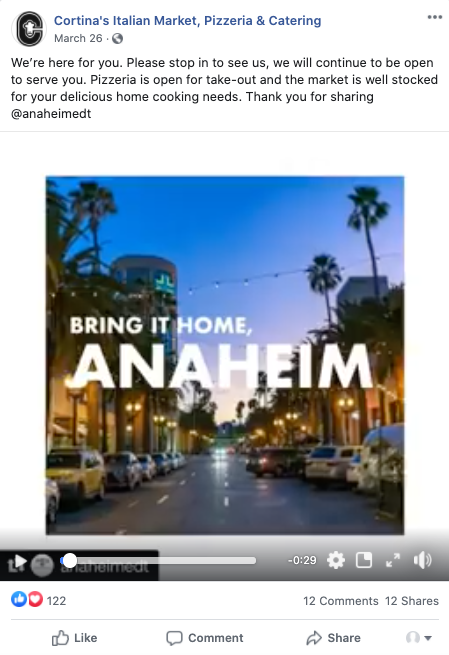
4. Leverage Facebook Insights
To beat the algorithm, you need to know how your content performs and you need to know who your audience is. The easiest way to do this is by going to the Facebook Insights tool located in Facebook Ads Manager.
When you navigate to the “Audience” tab of the insights tool, you can check out various metrics about your current and potential audiences, including top cities and countries they’re located in, and demographics like age and gender.
It’s a far reach from the audience analyses we used to have when Audience Insights (an old-fashioned version of this tool) existed, but it can still give you some valuable insight to inform your strategy.
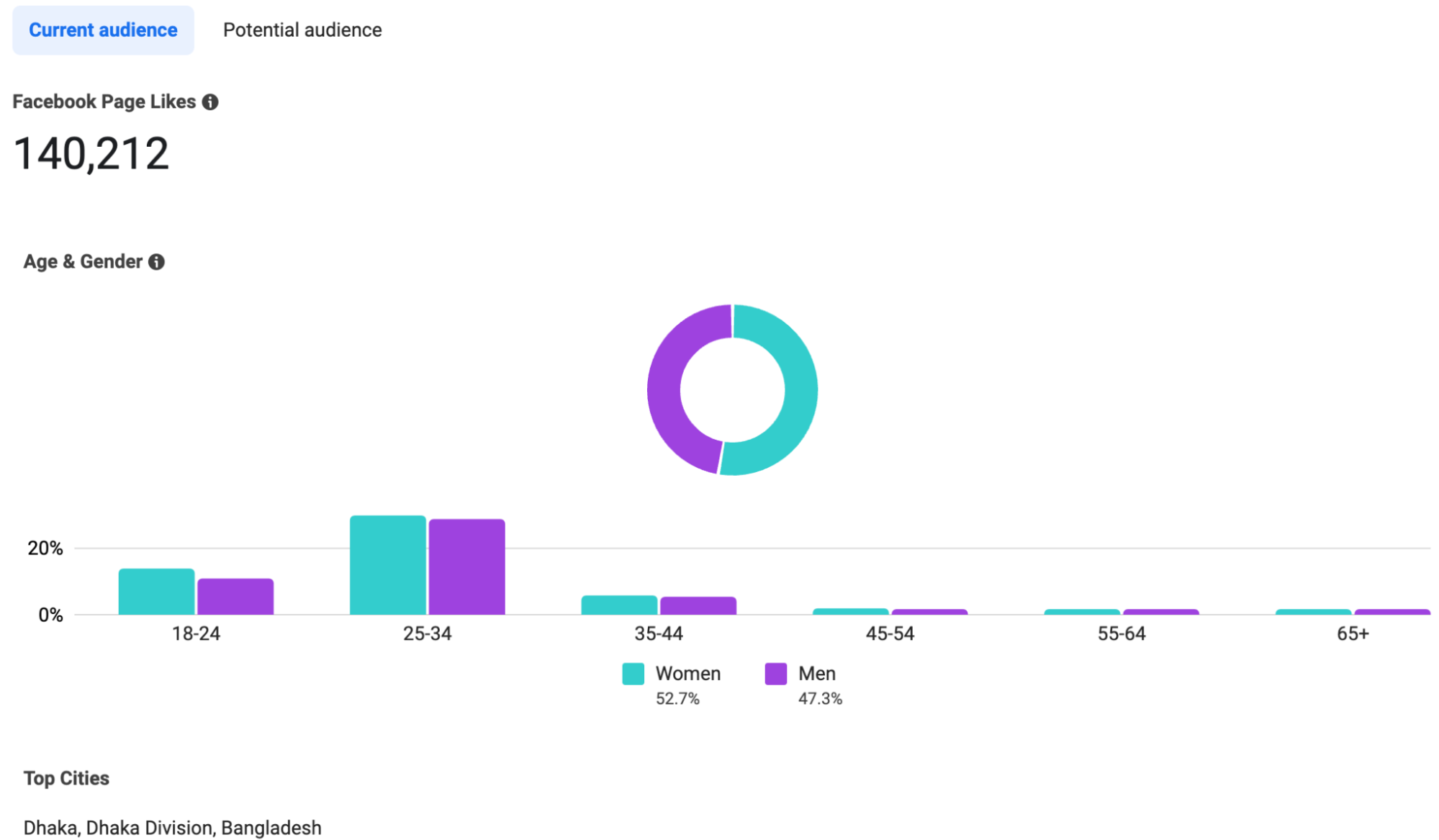
You can also see metrics on your Facebook page performance by navigating to your Facebook page and clicking “Insights” in the left-hand navbar.
While this overview won’t tell you much about your specific audience, it can help you stay on top of posts, traffic, and engagement trends which can be useful in evolving your strategy.
5. Post at the right time
I’m sure you’ve heard the phrase “timing is everything.” That’s just as true with your content pushes. If your audience isn’t online or doesn’t seem interested, you should consider posting at a different time.
Recency is another “signal” that helps decide which post to show. So the newer, the better.
You need to post during peak engagement hours. Every brand is different because they all have a unique audience. If you don’t know what time of day your audience is most active, try posting at different times of the day and track performance over time.
If you run ads, you can use “day” breakdowns first to see what days of the week your ads perform best. That can be a good baseline to test out with your organic posting schedule, and you can narrow it down to specific time windows from there.
Once you know when your audience is online, plan your content calendar around that to publish at the right moment. The timing is just as important as the content itself.
For example, if you sell a B2B service to businesses who typically don’t work on the weekends (and probably prefer not to think about work on the weekends), then why would you post on the weekends?
6. Avoid “down ranked” content
Facebook has various categories of content that they will flag to “down rank.” And this doesn’t just apply to the offending post but also the offending page. To avoid this, steer clear of
- gray area content (the content isn’t exactly prohibited, but it lives in that gray area…and you’re aware of it)
- “fake news” or misinformation
- sensational health claims and misleading health information (e.g., “Guaranteed to help you lose weight”)
- manipulated videos, also known as “deepfake” videos
The easiest way to avoid down ranking is to follow this rule of thumb: “if you have to ask, just pass.”
7. Be video-focused
As we mentioned, Facebook has continued to make video a top priority. Also, Facebook itself has said that video drives better engagement.
So video needs to be baked into your strategy some way, somehow.
If that’s making your pocketbook nervous, video doesn’t have to be expensive. Not everyone has a film and production crew handy, so there are many inexpensive and sometimes free ways of producing high-quality videos for your content posts. Here are just a few of those ways:
- Promo.com: At KlientBoost, we’re big fans of Promo. Their tool has a flat monthly price and countless video templates that make producing and editing high-quality videos a breeze. The best part is that it’s at a fraction of the cost of a production-quality video.
- User-generated content: More commonly known as UGCs, user-generated content helps leverage a cheap and sometimes free way to get video content for your brand. This could be a customer (often influencers) who upload a video reviewing, unboxing, etc.
- Facebook Live: Facebook Live is a free and great way to engage with your brand. It allows your audience to have direct access to you and interact with you in real-time. It’s also been found that Facebook Live videos receive an average of six times as many interactions than regular videos.
Makeup giant Sephora has done a great job staying engaged with its audience by frequently using Facebook Live to showcase makeup tutorials, which drive powerful engagement.
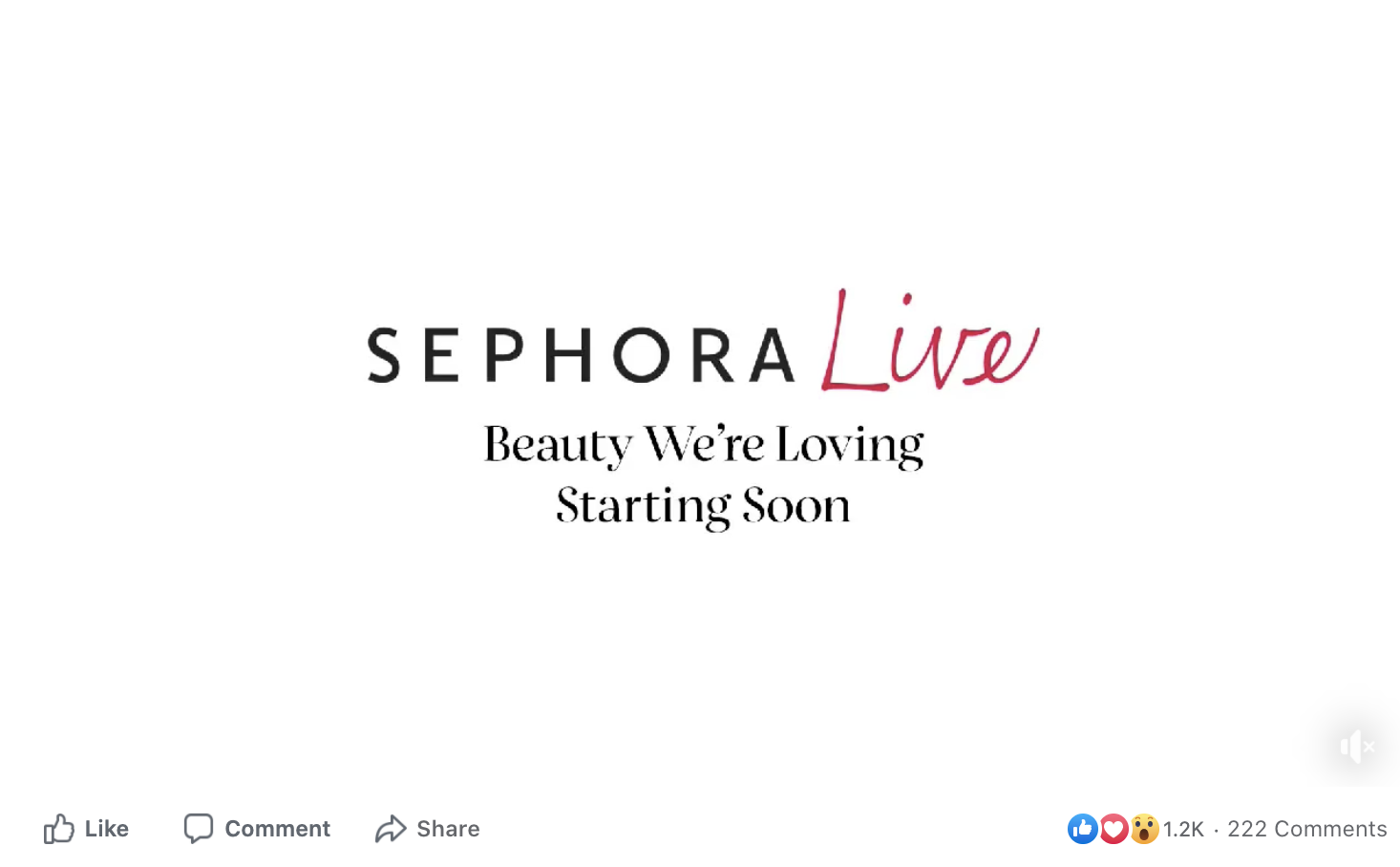
8. Be consistent, consistently
Brands everywhere think they need to post every day or multiple times a week to stay relevant. While that may be the case for some, that’s not the case for all brands.
The truth is, you need to post at whatever cadence works best for your brand.
Facebook has also said that one of the algorithm’s determiners of how meaningful pages or groups are to a user is based on how often they post. So while you don’t need to post like crazy (you don’t want your brand to appear spammy), you do need to post regularly.
Figure out when your audience is most engaged with your posts, and keep a consistent pace of posting to stay relevant (not annoying) to them.
9. Join relevant Facebook Groups
Although there are constant changes to the Facebook platform, Facebook does a good job of keeping you up to date with these changes.
At Facebook’s 2019 F8 Conference, Zuckerberg announced there would be a big push to make Groups a cornerstone of Facebook. They’ve stayed true to their word through continued advertising of Facebook Groups, including this popular TV commercial on a basset hound Facebook Group.
The most important announcement from the F8 Conference was when Facebook said people “may see more content from Groups in their news feed.”
So what does that mean for your brand?
We recommend you join relevant Facebook Groups for your brand and audience and start some conversations there. You don’t want to be “salesy” in the group—that’ll leave a bad taste in everyone’s mouth. Just start ordinary conversations, be personable, and represent your brand the best way you can.
If you’re extra adventurous, consider starting your own Facebook Group. It doesn’t have to be specific to your brand as a whole. It could center around brand themes (where the goal is to get conversations started), discuss, educate, solve problems, and, most importantly, engage with your audience.
10. Ask for follows (the right way)
Your brand has fans, even if it’s new to the scene.
You might have friends, family, early customers, or just the buddings of general fans and supporters. If they aren’t already following you, they should be. 😉
So why not ask for it?
The key here is to avoid “engagement baiting” and clickbaiting, though.

While posting on Facebook, you shouldn’t explicitly ask for a follow, like, comment, or share like this. You want that to happen naturally.
So, ask for follows outside of Facebook, especially on high-profile content. Do you have a blog post that gets a lot of traffic? Casually ask for a follow at the end. What about a YouTube video that’s trending? Ask for a follow at the end. You get the picture.
11. Have your audience prioritize you
Facebook has done a lot of work helping its audience control what they see on their feed. From surveys to brand lift studies, they want to put the most relevant content at a user’s fingertips.
To make that even more apparent, Facebook rolled out the “see first” feature we talked about, which then evolved into the “Favorites” feature. This feature allows users to decide what content appears first on their Facebook feed.
Now, while you can’t outright create a Facebook post to beg your audience to “add your brand to their Favorites,” you can do it in a tasteful way outside of Facebook.
On external sites (like a company blog) or during phone calls, onboarding, or wherever you ask for page followers, tell your potential customers they can also add your page to their “Favorites” if they’re so inclined, so they’ll never miss an update from you.
The best way to outsmart the algorithm is to get your audience to tell the algorithm they want you.
Of course, this will work best if you are producing high-quality content that your audience actually loves. If you aren’t driving a meaningful impact, why would they choose you first?
12. Ask open-ended questions
As I just mentioned, Facebook hates engagement baiting. But even if you can’t explicitly ask for a comment by saying “Comment below,” you can ask for comments without explicitly asking for comments by proposing an open-ended question.
An easy way to do this is to poll your audience and let them lead the discussion.
Loot Crate did a great job with this by sparking a conversation about Marvel characters in their ad. Their open-ended question of “Who is the funniest character in the MCU?” to their Marvel-loving audience led to over 2,700 reactions, almost 200 comments, and almost 500 shares.

12. Get brand advocates involved
A great way to build up your engagement on Facebook posts and beat the algorithm is to get your brand advocates involved, especially early on in building a brand.
A brand advocate isn’t necessarily a customer. It could be anybody—friends, family, employees, or general fans and supporters.
This is huge, especially with Facebook prioritizing content from friends and family. If you want to expand your reach, get your advocates involved in spreading the word. The reach will follow.
14. Put the platform first
This tactic is quite simple.
If you want to grow your audience on Facebook, expand your reach, and build engagement, the easiest way to do that is… well, to keep users on Facebook.
Many businesses try to link back to their site and get people to take a specific action. That’s a great strategy for advertising, but not necessarily for your organic posting on Facebook. There’s a time and place for it.
Instead of linking externally, build engagement by posting videos, photos, and Facebook Live sessions.
Of course, you may want users to buy a product now. But if you don’t want Facebook to shuffle your posts to the nether realms of the feed, keep your audience on Facebook. The more engaged your audience is, the more likely it is that they’ll gravitate toward your site on their own in the future.
15. Make each post unique, even if it’s repurposed
This strategy is one of my favorites because it’s also applicable to advertising on Facebook.
In short, it’s tough to continually come up with new content (or ad) ideas. It’s very common for people to run out of ideas for content to promote.
A common strategy many use when the creative well runs dry is repurposing content.
It’s okay to re-post a previous post that drove great engagement. But the key is to make it different each time.
Although the “content” of the post itself is the same, test variations each time you repurpose. You could test new imagery, a new headline, or new body text altogether.
Tales of the Cocktail did a great job repurposing an old high-engagement piece of content years later. By switching up the text, they were able to drive 2x the reactions and 10x the comments.
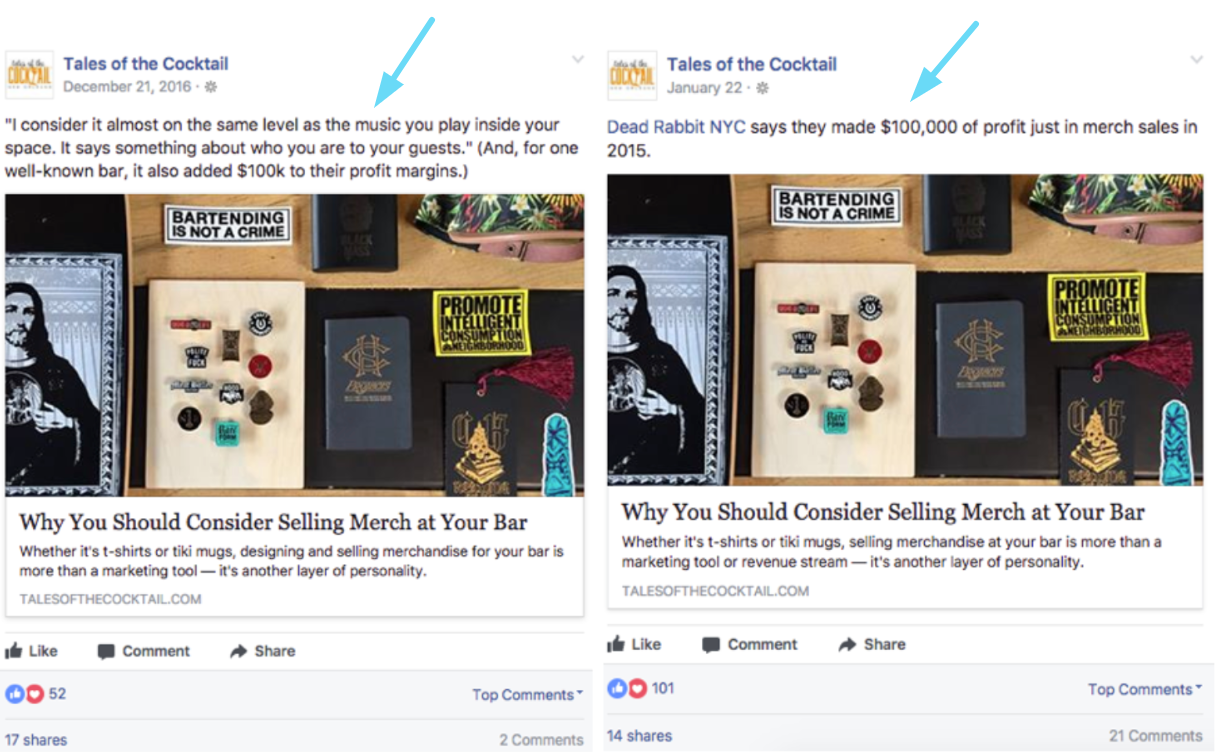
16. Make it Facebook official
I’m not talking about the “becoming boyfriend and girlfriend” type of official. What I mean is that it’s time to get Facebook verified.
This infamous blue (sometimes gray) badge is your rite of passage into legitimacy on Facebook. This not only proves your business’s legitimacy to Facebook, but it also proves to your audience that you have a strong brand presence.
What verification does is prove that you are who you say you are, shows overall authenticity, and ultimately helps you get a higher news feed ranking while people are scrolling.
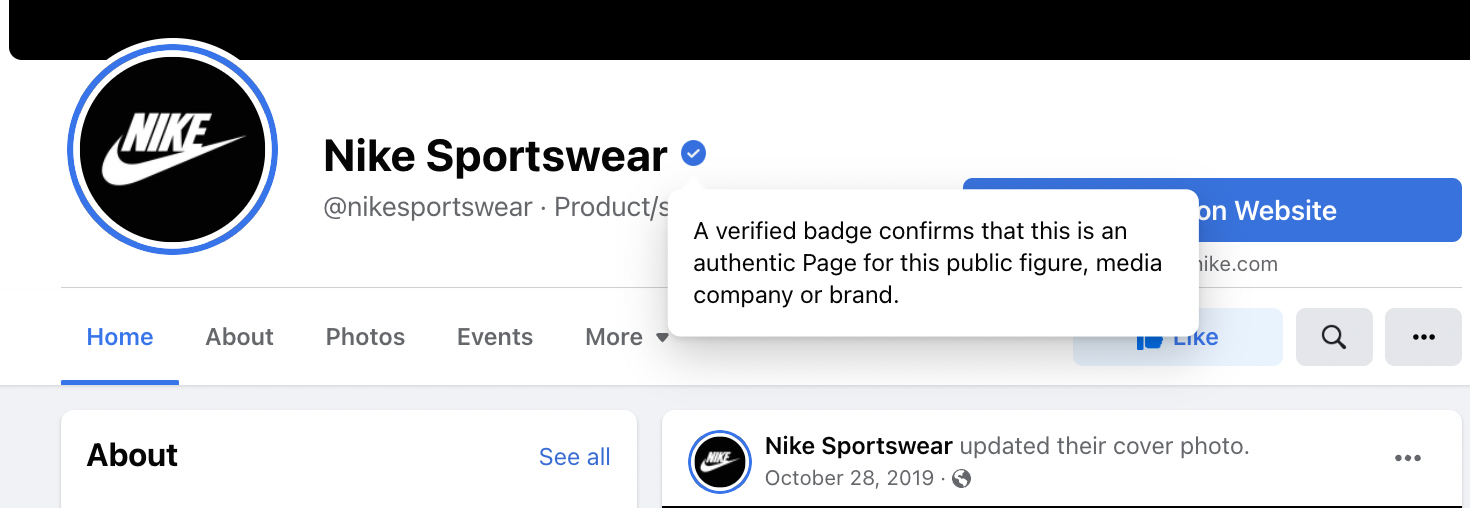
17. Utilize hashtags
Just about everyone these days is familiar with hashtags (#overit). But hashtags, if executed correctly, can lead to some real marketing success, especially on Facebook.
By implementing hashtags, you’ll be able to reach people you previously couldn’t while they’re searching for similar topics.
Here are a few quick hashtag tips:
- Keep it relevant: Keep them relevant to the post and relevant to your brand. Don’t let people find you for entirely irrelevant topics.
- Don’t overuse hashtags: You don’t need to use them in every post, and you also don’t need to use 127 per post.
- Use the same hashtag across all social media platforms: You don’t want to have to manage different hashtags across Facebook, Instagram, and Twitter.
- Be original: Create your own unique hashtags if that applies to your business.
18. Reply to your audience
This may sound self-explanatory…but you’d be surprised how many businesses don’t reply to their audiences.
If someone comments on one of your posts, reply. Be available. Let them know that they are heard.
Encourage that engagement, or you’ll lose it.
In addition to the user feeling heard, your response also brings your brand to life and gives it a voice.
19. Don’t forget the power of paid ads
The hardest part about organic posting is that it’s tough to scale. Using Facebook Ads is one of the easiest ways to scale your business at a relatively low cost.
We’ve already talked about Facebook’s targeting capabilities and how ad creative makes a significant impact organically. Advanced targeting tools are available to you in the Ads Manager, too, and creative is just as important to advertising.
The most successful brands on social media marketing platforms supplement organic strategies with paid ad efforts. This is how they expand overall reach and grow their business.
Take our client, ShipStation, for example. They started Facebook Ads with us and increased their number of sign-ups by 400%.
Facebook ads help your brand get better visibility, more reach, and increased engagement, typically in a more controllable way than organic.
If you’re not already running digital marketing ads on Facebook or haven’t at least tested it, why the heck not?
Go tackle that Facebook algorithm with confidence
Facebook still remains one of the easiest and most convenient sources of reaching a wide audience.
Establishing a presence, understanding your audience, and learning how and when to best reach them are all critical factors for continued success and growth.
And although Facebook keeps us on our toes with algorithm changes, they do roll them out in a way that’s accessible and easy to adapt to. That helps businesses better understand how to tweak their Facebook strategies in response.
It’s essential to continually stay up-to-date on the algorithm to know how to beat it.
You’re the algorithm expert now. Armed with knowledge from past to present, plus a hefty list of tricks to outsmart the algorithm’s AI. We’d say you’re ready to break through the barriers holding you back on Facebook.
And if you’re ready to take tip #19, read our next article about starting up on Facebook Ads.
So get started…and get seen. 👀